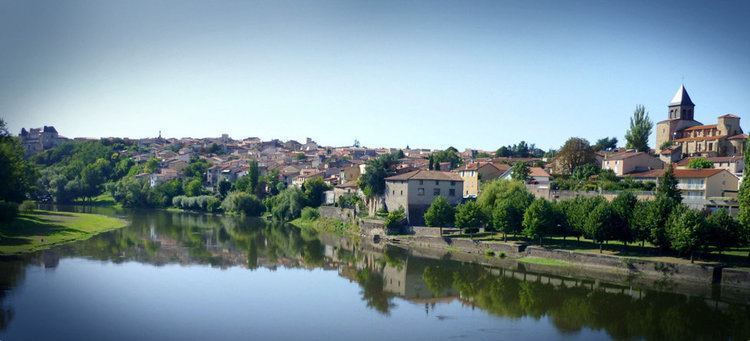Population (2006) 10,102 | Intercommunality Clermont Communauté Area 21.61 km² | |
 | ||
Arrondissement | ||
Petit tour de moto tranquille dans pont du ch teau 50cm3
Pont-du-Château is a commune in the Puy-de-Dôme department in Auvergne in central France.
Contents
- Petit tour de moto tranquille dans pont du ch teau 50cm3
- Map of 63430 Pont du ChC3A2teau France
- Geography
- Transportation
- History
- Origins of the city
- The medieval city
- The traditional city
- At the century of the lights
- The 19th century
- Partner cities
- References
Map of 63430 Pont-du-Ch%C3%A2teau, France
Geography
Located 15 km from Clermont-Ferrand (15 minutes by car), Pont-du-Château is a regional town lying near a strategic crossroad of motorways connecting Paris to Barcelona and Lyon to Bordeaux. Pont-du-Château integrated into the Clermont Community on 1 January 2004. This union reflects the will to realize projects in which development and solidarity are key words. Since joining this community, Pont-du-Château has on a large territory of more than 30,000 square meters with 283,000 inhabitants.
Transportation
Pont-du-Château a city at the crossroads of the regional parks auvergnats. At a few minutes by car you can discover the Regional Natural reserve of the Volcanos of Auvergne and the Regional Natural reserve of Livradois-Drill.
History
The museum recalls the life of the boatmen and Castelpontins, through many objects, models and documents. The museum is open every day in July and August and on return you remains to it year
Origins of the city
Three boroughs born at the time Carolingian, without one being able to give too precise dates. In the Paulhat west: already during Roman peace existed in the large marsh known under the name of Limagne, of large Gallo-Roman farms, Redon, Picou, Tourette Chazal, but at the time Carolingian the village of Paulhat grows, with the foot of the hillocks of Littes and from Ruchon… If the village of Machal, born with paleolithic under Puy de Mur disappeared, during the invasions Normans appeared on the strengthened hillock, the church co. Martine surrounded by a village which lived activities related to the river Allier.
The medieval city
Guy de Dampierre seized Bridge-of-Castle in 1212, on behalf of the King de France, Philippe Auguste, which attached the city to the crown. Become in the 13th century a true citadel with its "old castle" and its single enclosure, Pilippe Auguste made a garrison city, it equipping soon with two new enclosures with turns, doors, Maigne, Bise, Barrière and carries vault of it, ramparts which one guesses in the plan of the old city. Two churches enriched this inheritance: Co. Martine, beautiful building of Romanesque art whose construction is spread out over several centuries since the 13th century, and recently restored with its rich person paintings of origin; Paulhat, disappeared from the marsh about 1356, rebuilt in the west of the fortifications in 1384, and again destroyed, it will cover in the 16th century, with the Rebirth, an astonishing architecture, a resurgence of the Romanesque art Auvergnat.
The traditional city
Guillaume de Montboissier Beaufort-Canilhac, lieutenant general of the army of Italy in 1654, of return in Auvergne, filled honors by Louis XIV, helped of his friend Mazarin, built the current castle, vis-a-vis the valley Allier; a civil architecture end Louis XIII beginning Louis XIV, with his crowned northern frontage of a terrace, its perron with double revolution, its broad southern terrace which overhangs gardens with the Frenchwoman. “It is of an approval which one does not see anywhere else” wrote the Audigier canon.
At the century of the lights
Philippe-Claude de Montboissier Beaufort-Canilhac, after 1750, undertook important installations in his castle: vast stables in the west, sculptures and facings ashlar of Volvic for the northern frontage of the principal masonry, installations interior facts of woodworks and paintings of the ceilings to the Frenchwoman, “the small castle”, beautiful residence at the entry of the court to receive its guests, the house of the guards, a theatre, superb cellars, without forgetting in the north of the city the park of the marquis, inspired by the famous landscape designer Ours, basins, alleys of more than 300 meters, aqueducts, thickets, etc. At the same time, between 1765 and 1773, Mr. de Régemorte designed a new stone bridge, which built Raimbaux father and wire, a bridge at our days indestructible in spite of the spectacular floods Allier, and which made it possible the royal road 89 to continue its route between Lyon and Bordeaux. Since nearly 150 years one crossed the river on a vat.
The 19th century
Pont-du-Château then had five ports: Vortille, them Palisses, Port of Bouères, Borders it St Aventin and the port of Upstream, which was the only port built on Combining it from Brioude to Moulins. The opening of the channel of Briare in 1642, the disappearance of the pélières in 1790, the coal mining of ground of Brewed protected by Colbert, the keen demand of fir trees by the masts of the fleet of Louis XIV, a wine extremely appreciated in the capital, of the hemp of good quality for gréement of the sailing ships, the reputation of papers of Auvergne and even passion of the architects for the stone of Volvic, and it was more than 3.000 fir plantations which each year descended To combine it, an incredible rise of the river navigation, a noisy harbour city of life, populated high marines colors. That the train will force a long time with silence since [1865], before it does not wake up in the modern world after 1960.
